VVAM Newsletter 84 – 2001
Friends of the Airborne Museum
Editors:
Drs. R.P.G.A. Voskuil
C. van Roekel
G.H. Maassen jr.
Newsletter No. 84, December 2001
Translated by Cathrien and Peter Clark
Representative in Great Britain: Niall Cherry, 3 Church Road, Warton, Lancs, PR4 1BD Tel. home 0177-2632764
23 September 2001. Following the September 1’1 attacks in the United States, the children who laid flowers on the graves in the Airborne Cemetery had made small flags bearing either the word ‘Vrede’ or ‘Peace’. After the memorial service the children gave the flags to the veterans.
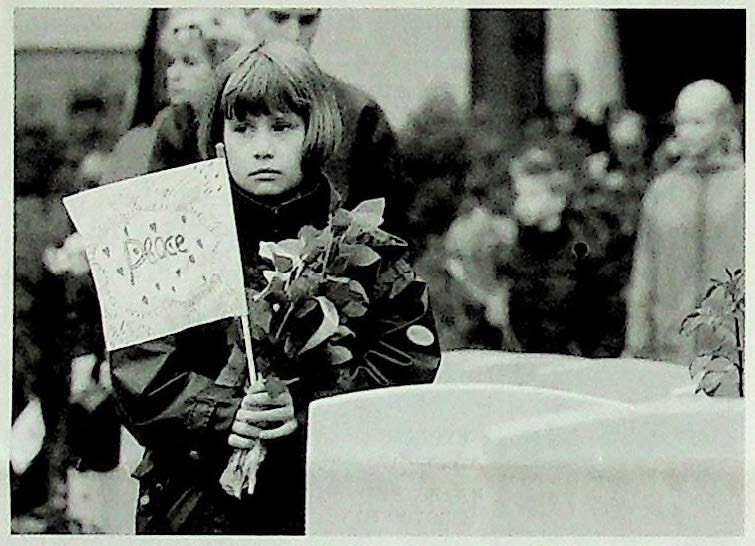 (Photo: Berry de Reus)
(Photo: Berry de Reus)
From the Editors
This Newsletter comes to you a little later than usual, the reason being that the bank did not permit distribution of the Giro subscription payment slips that always accompany the autumn issue, until 1 December. And that was due to the forthcoming introduction of the euro. The treasurer will explain more below.
The newsletter is again a double issue so that extra articles and photos could be included.
As in previous years, the commemoration of the Battle of Arnhem was attended by a huge number of people. Besides the usual programme there were a number of informal get-togethers: reports later in the newsletter. The September the 11 th atrocities in the United States made an indelible impression on this year’s commemoration, as can be seen from the above photograph.
For the last few months we have had to get by without our chairman and co-editor, Chris van Roekel. Chris was admitted to hospital with serious heart trouble. He underwent a complex operation, which fortunately he came through very well, and there now follows a, probably lengthy, rehabilitation period. Because of the decline in his health Chris has decided to resign his chairmanship at the AGM early next year. He intends taking things a bit easier but will remain available for a number of activities within the Society. We shall return to this subject in the AGM report in the next Newsletter.
Royal visit
On Wednesday 19 September Crown Prince Willem- Alexander and his bride-to-be, Maxima Zorreguieta, visited the Airborne Museum ‘Hartenstein’ in Oosterbeek. This formed part of their Official Visit to the province of Gelderland.
After first visiting Arnhem and Zevenaar, the engaged couple arrived at the Airborne Museum at a quarter past four, greeted by a welcoming crowd of several hundred people. Following an aubade performed by five choirs from the municipality of Renkum, the couple entered the building. The Aidermen and the trustees of the Airborne Museum Foundation were introduced, and this was followed by a word of welcome from Mr Verlinden in his dual capacity as burgomaster of Renkum and chairman of the Foundation board. Museum director Mr Boersma then gave a short explanation of the Battle of Arnhem. He also explained the way in which the museum, together with the Society of Friends, endeavours to keep alive the memory of this Battle. Prince Willem-Alexander mentioned that he had visited the Hartenstein once before, during his school days.
On behalf of the Foundation board the chairman presented a copy of Martin Middlebrook’s 1994 book ‘Arnhem 1944, The Airborne Battle’. Because of the limited time allowed for the visit only a part of the museum could be viewed, that chosen being the diorama section where Mr Groeneweg provided explanation. Meanwhile four veterans, including Ted Shaw, SFAM’s former representative in the UK, and a number of children had arrived in the Hartenstein’s Great Hall. HRH Prince Willem-Alexander and Maxima spent some time talking to them there. As an end to the visit the couple, accompanied by the veterans and the children, appeared on the museum terrace, giving the gathering crowd and press the chance to take photographs. This was immediately followed by a farewell reception at the Kleyn Hartensteyn restaurant, which the Foundation board’s chairman, vice-chairman and Gerrit Pijpers (visit co-ordinator) also attended.
The Airborne Museum can be justifiably proud to have been chosen to welcome the princely couple. The visit received copious media attention and photos of this exceptional afternoon can also be found on the Hartenstein website, www.airbornemuseum.com
(W. Boersma)
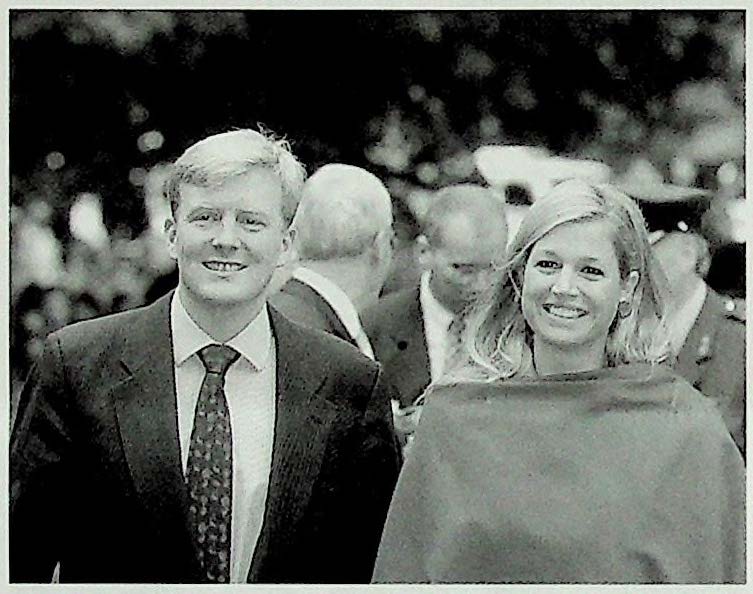 Wednesday 19 September 2001. Willem-Alexander and Maxima arrive al Hie Airborne Museum.
Wednesday 19 September 2001. Willem-Alexander and Maxima arrive al Hie Airborne Museum.
(Photo: Berry de Reus)
Medals
Shortly before and during the commemorations in September, the Airborne Museum was again the recipient of various sets of medals, belonging originally to the following veterans:
Corporal J. Arkinson, lsl Battalion The Border Regiment;
Private Harry Boardman, 156 Parachute Battalion;
Private Norman Burrell, lsl (Airborne) Division Workshop, Royal Electrical & Mechanical Engineers; Driver Ronald A. Clancy, Air Despatches
63 Composite Company, Royal Army Service Corsp; Fred Mason, Royal Air Force (Volunteer Reserve); Johannes Penseel, Home Forces;
Private Fred Tracey, 156 Parachute Battalion.
The sets were placed in the medal display cabinet by Mr Duyts. One of the museum’s volunteers, Mr Dirk Knoop, has begun compiling a documentation file containing all details of veterans whose medal sets are displayed in the museum.
From the Treasurer
Normally, a Giro payment slip for next year’s subscription payment is enclosed with the November Newsletter. Up till now this has been in guilders. The payment slip that you receive this time is exclusively for payment in euros, and the Post Office Bank would not allow distribution of this slip before 1 December: no Giro slips in euros would be processed before that date. We therefore decided to delay issue of the Newsletter until after 1 December. Further explanation is given in the appendix to the Giro slip.
(Frits Miedema)
Plaque
On 20 September last a small plaque was unveiled near the ageing lime tree in front of the Old Church. The tree saved the life of Glider Pilot Mark Leaver in September 1944. Mark Leaver, who landed with his glider at Wolfheze on 18 September 1944, subsequently fought in the Lower Village in Oosterbeek. At a certain point he was standing near the church with four other British soldiers when a German shell exploded nearby. Four of the group of five were killed instantaneously. Leaver survived the explosion because he was protected by the tree, and he has always regarded this as a miracle. He was very keen that this fact should be remembered by the placing of a small plaque.
Sadly, Mark Leaver passed away in October last year, but thanks to the efforts of the Visser family from Zelhem, with whom he stayed each year, his last wish has finally been realised. Following consultation with the custodians of the Reformed Church the placement of a small plaque next to the lime tree was permitted. It was unveiled by Mark’s widow, Mrs Muriel Leaver.
Over the years the hole in the tree caused by the shell in 1944 has assumed the shape of a heart.
Ashes of British veterans interred
A short service was held at the Airborne Cemetery on Friday 21 September during which the ashes of two recently deceased veterans – Sergeant Harry ‘Jack’ Spykes (IO111 Parachute Battalion) and William Avery (2nd Parachute Battalion) – were interred. Together with their families the widows of the veterans brought the urns containing the ashes from England to Oosterbeek. In addition to the family members a large number of veterans and others attended the short ceremony, which was led by The Reverend R.A.W. Boyce.
Captivating lecture by Stuart Eastwood
On the Sunday afternoon of 7 October, 35 members of the SFAM gathered in the back room of the Schoonoord Restaurant in Oosterbeek to listen to a lecture by Stuart Eastwood on the history of the 1st Battalion The Border Regiment. The speaker told a clear and extremely informative story, illustrated with a series of interesting slides.
At the end Mr Eastwood invited questions, of which there were many. Long after the lecture was over many of those present stayed behind discussing the subject.
From the enthusiastic reactions of the audience it would seem that the initiative for holding such ‘mid-term’ lectures has fallen on fertile soil. Perhaps we shall organise more of these specialised talks in the future on subjects connected directly or indirectly with the Battle of Arnhem. One can think of all manner of less well-known aspects of Operation Market Garden; of the history of the various British Airborne units and the Polish Brigade, the Royal Air Force, and of the role of certain German units. One can also imagine more technical subjects, such as weapon systems.
Any member wishing to give a similar lecture on a specialised topic before a limited audience is welcome to contact Eugene Wijnhoud, Bernhardlaan 41-1, 6824 LE Arnhem; telephone 026 3513100, e-mail e.wijnhoud@12move.nl.
Oosterbeek, the Schoonoord restaurant, 7 October 200’1. Stuart Eastwood receives a bottle of Airborne beer from Eugene Wijnhoud as a ’thank you’ for his interesting lecture on the history of the 1st Battalion The Border Regiment.
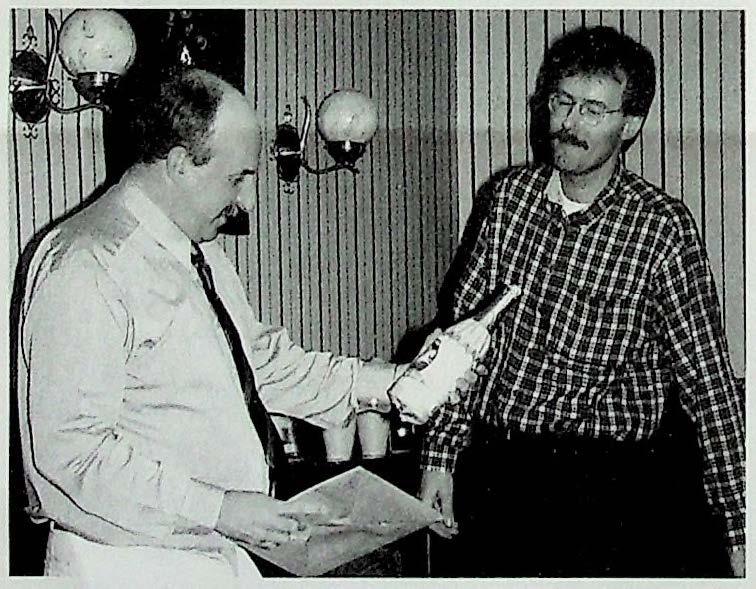 (Photo: Wybo Boersma)
(Photo: Wybo Boersma)
(Robert Voskuil)
Members evenings
On Fridays 11 January and 22 March 2002, the Airborne Museum will be organising evenings for members of the Society of Friends. If possible the archive and depot will be open during these evenings.
The aim is to allow members to meet one another and exchange ideas in a relaxed atmosphere. Extra tables can be provided on request on which members can lay out documents and/or material that may be of interest to others.
The ‘evenings’ will begin at 19.00 hours.
(Wybo Boersma)
New information boards
During walking holidays in England I couldn’t help noticing how well the routes were indicated. Furthermore, in many places excellent information boards were provided. Over the years, during various British Battlefield Trust conferences, I have seen how battlefields can be signposted. It had long been a cherished wish of mine to improve the battleground indications and the information provided along the walking routes in Oosterbeek that have to do with the Battle of Arnhem.
Years ago the Society of Friends set out two walks indicated by small marker posts. A simple folder was available containing information about the events in September 1944 and a small map. The project was later taken over by the local tourist board.
Some years ago Renkum council appointed a person to deal with tourism policy, Pieter W. Zwaan. Among other things he took a close look at the walking routes in the municipality. There were more than forty. Around the Hartenstein alone there were at least five different routes, each overlapping the other in places. Revision of all these routes provided a good opportunity to realise the need for better information.
The various walks in Oosterbeek relating to the Battle of Arnhem have now been reduced to one ‘Perimeter Route’, indicated with uniform signposting. A clear information board at the Airborne Museum gives an overview of this and other walks in the vicinity. A total of eight information boards have been placed along the route, each with a photograph of the local situation as it was in 1944 and explanatory text in Dutch and English.
The boards are located at the following places: the Airborne Museum, the REME bench and tennis court behind Hartenstein, the Border Regiment mortar pit at Van Lennepweg, the hill at Benedendorpsweg with the view over the Rhine, along Kerkpad by the flood plains, at De Tafelberg and at the Schoonoord restaurant.
A board has been in place at the Old Church in the Lower Village for some years.
The texts were prepared and translated by museum staff and the boards were designed and manufactured by a professional body. Final checking of the texts was done by Geert Maassen, and Renkum council met all costs. The entire project, which was led by Mr Zwaan in close co-operation with Renkum council, the Airborne Museum and the Friends’ Society, was brought to a successful conclusion. The next project to be tackled is an improved Airborne Cycle Route.
(Wybo Boersma)
Successful theme afternoon
The theme afternoon announced in the previous Newsletter took place on Saturday 3 November. It was held in the hall of the ‘Overdal’ care home in Oosterbeek due to double booking of the large hall at Zalencentrum ‘Lebret’.
Before the break Patrick Pronk, using slides and overhead sheets, gave an overview of the part played by the 9″’ (Airborne) Field Company, Royal Engineers during the Battle of Arnhem. Patrick dealt with the subject in a brisk tempo before answering questions from the floor.
After the break the BBC documentary on Operation Market Garden from the series ‘Battlefields of the Second World War’ was shown. The documentary was compiled last year by Professor Richard Holmes.
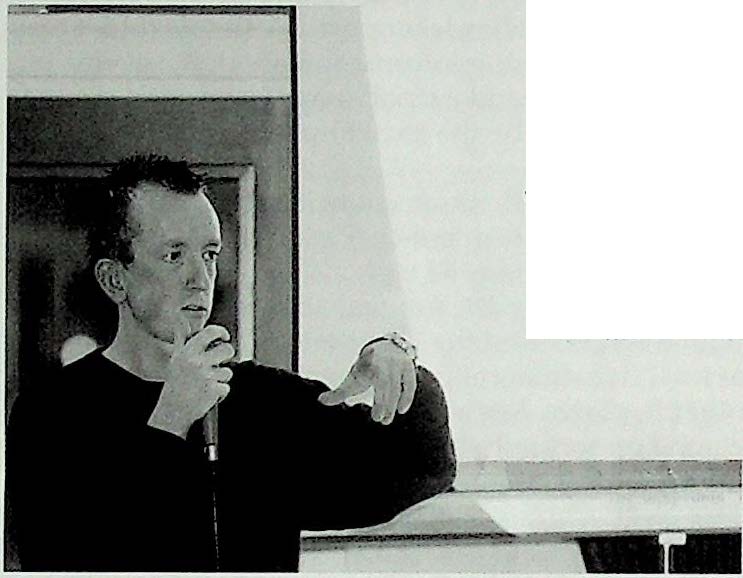 On 3 November Patrick Pronk gave a lecture on the 9lh (Airborne) Field Company Royal Engineers in ‘Overdal’ care home, Oosterbeek.
On 3 November Patrick Pronk gave a lecture on the 9lh (Airborne) Field Company Royal Engineers in ‘Overdal’ care home, Oosterbeek.
(Photo: Berry de Reus)
Normandy Excursion 2002
For those interested, the Airborne Museum ‘Hartenstein’ is organising an excursion to Normandy that will run from 29 May to 2 June 2002 inc. It will be led by Society member Jacques Haegens.
The programme will be virtually identical to that of the excursion organised by the Friends’ Society in 1998. Places visited will include Arromanches, the coastal battery at Longues-sur-Mer, the American Cemetery at St. Laurent, Omaha Beach, Point du Hoc, Utah Beach, St. Mere Eglise,
La Fiere, the German Cemetery at La Cambe, Pegasus Bridge, Ranville, the coastal battery at Merville, the Sword, Juno and Gold invasion beaches, the monument to Field Marshal Montgomery, Luc-sur-Mer, Courseulles, the invasion museum at Bayeux, Tourville, Cote 112, Falaise, St. Lambert-sur-Dives, Moissey, Corridor of death and Mont Ormel.
The tour costs 387 euros per person, which cover the five-day bus journey including excursions, four nights’ accommodation in the Campanile Hotel, Bayeux in double rooms (two people sharing) based on half-board (two lunch packets included), admission charges to four museums and a comprehensive documentation folder. The surcharge for a single room is 80 euro. Travel and cancellation insurance need to be arranged by the participants themselves.
Profits from this excursion will go towards the furnishing of the new ‘Frost Room’ in the Airborne Museum in which the Rhine Bridge in Arnhem will form the focal point.
For information and bookings contact the Airborne Museum, Utrechtseweg 232, 6862 AZ Oosterbeek: telephone 026 3337710, fax 026 3391785, e-mail info@airbomemuseum.com. A booking form will then be sent to you. Conditions of payment: 87 euro on application, 300 euro before 1 April.
(Wybo Boersma)
Video: The Animated Military History Series, “Arnhem”
A new video about Arnhem has been released by Cromwell productions in the ‘Line of Fire’ series. The ‘Arnhem’ episode was recently shown on the British History Channel, and it is now available on video. Among those who worked on the production are the well-known Colonel Robert Kershaw (author of the book ‘It Never Snows in September’), Lloyd Clark, lecturer at Sandhurst Military Academy, and staff from the Airborne Forces Museum in Aidershot. Aad Groeneweg provided support from the ‘Hartenstein’ museum.
Despite this august body of experts, the video is somewhat strangely put together. The majority of the film has nothing to do with Arnhem, probably because it was too expensive to incorporate more original scenes. There is even a clip of a Norwegian commando taken on Walcheren in November 1944! A number of animations are included in the video and these too have little to do with Arnhem. Many scenes are often repeated; for example, the WS 22 radio transmitter in the museum in Aidershot is shown three times. Furthermore, the story does not always match historical fact.
All in all a shame, and a missed opportunity for this new production. Sadly, the previously produced videos ‘Theirs is the Glory’, ‘A Bridge Too Far’ and ‘Arnhem 1944′ are no longer available, so we just have to make do with this documentary. Seeing what it offers, the video is quite pricey. The film is in English, is not sub-titled and, for the time being, is on sale at the Airborne Museum.
The Animated Military History Series “Arnhem”, released by Cromwell Productions, England. Duration, 50 minutes, in English (not sub-titled). Price 55 guilders.
(Wybo Boersma)
Commemorative envelope
On September 17 2001 the Airborne Museum Hartenstein’ issued the latest in its series of commemorative envelopes, this being the sixth in the series featuring ‘Monuments of the Battle of Arnhem . The envelope shows the monument to the British and Canadian Engineers who carried out the successful evacuation of the remnants of the 1st British Airborne Division during the night of 25/26 September 1944.
The monument is located on the south bank of the Rhine on the Drielse Dijk, opposite the Old Church in Oosterbeek, and was unveiled on 15 September 1989. It was designed by Society member H. van der Brand from Arnhem.
When it became clear that the bridgehead at Oosterbeek could not be held, the British high command decided on 25 September 1944 to evacuate what remained of the T‘ British Airborne Division. More than 2000 survivors gathered on the river flood plains under cover of darkness. That night, British 260 and 553 Field Companies Royal Engineers equipped with rowing boats, and 20 and 23 Field Companies Royal Canadian Engineers in boats with outboard engines, ferried 2398 servicemen back across the Rhine. All the wounded, most of the medical personnel and the clerics remained behind and were taken prisoner.
Nine engineers lost their lives during the operation. The monument on the Rijndijk commemorates the efforts of all engineers involved.
The issue of this envelope is connected with the ‘Airborne Engineers, the Engineers during the Battle of Arnhem’ exhibition that was held in the Airborne Museum this year.
Five hundred numbered envelopes were produced and they were franked with the Oosterbeek post office branch stamp on 17 September 2001.
As tradition demands, envelope number 001 was presented to the leader of the Pilgrimage, Mr Jasper Booty.
The commemorative envelopes are on sale at the Airborne Museum in Oosterbeek at 7 guilders each.
If you wish to complete your series, a limited number of envelopes from previous years are still obtainable at the museum. You can also visit our website: www.airbornemuseum.com.
Obituary: Dave Morris
We have been informed by the Controller of the Airborne Forces Security Fund that Dave Morris passed away on 24 October 2001.
In September 1944 David Morris was Regimental Quartermaster Sergeant in HQ Company, 11″’ Parachute Battalion. He landed at Ginkel Heath on the second day of the Battle of Arnhem and arrived in Oosterbeek with a few other soldiers during the evening of 18 September. They spent the night there in the Hartenstein.
Next morning they were sent via Utrechtseweg to Arnhem where they became engaged in heavy fighting in the vicinity of Oranjestraat. Dave and a number of other men managed to advance along Utrechtseweg and Bovenover to beyond Arnhem station, but the German superiority in numbers forced them back to the Rijnhotel via Rijnstraat and Onderlangs. They then continued their withdrawal to Oosterbeek.
Next day, among other tasks, Dave helped with the transport of wounded to the emergency hospitals in Vreewijk, Schoonoord and de Tafelberg.
On 21 September he was ordered to go to Benedendorp. There, together with other soldiers, he defended the house ‘Vredehof’ until 24 September. The house was the home of the De Soet-Hupkes family and stood at the corner of Weverstraat and Fangmanweg.
In 1945 Mr Frans de Soet recorded his experiences in the story ‘The last days of the house Vredehof’ that was published in the book ‘Not in Vain’ (Arnhem 1946). David is mentioned a number of times in the book.
After Dave Morris was taken prisoner on 24 September, along with his mates Pte Jimmy Kerr and L/Cpl Harold Cook (both from the 11th Parachute Battalion), they were marched off along Weverstraat, De Dam and Fangmanweg. As they walked with their hands up along Weverstraat, before turning right into De Dam, they were photographed by a German war photographer. This picture appeared in several publications, thereby becoming very well known.
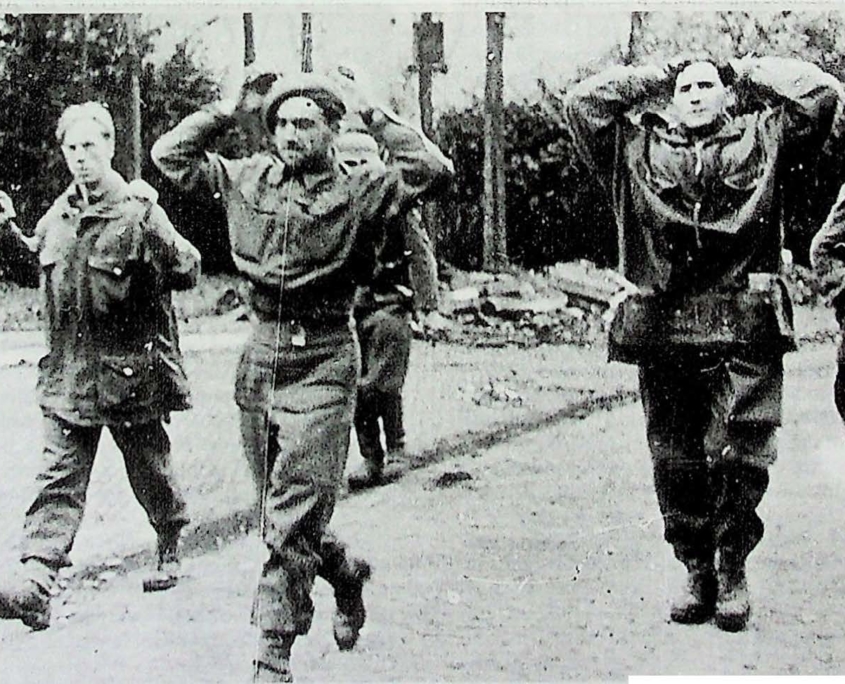
At the point where the men had crossed De Dam and turned left into Fangmanweg, the group was filmed by a German film cameraman. Dave is recognisable in this film clip by his mop of black hair without beret. Near the small white house, the home of the Esmeijer family, he turns around briefly and then continues walking on.
Another, less well known, German photo of Dave Morris exists that was taken while he was being questioned near the entrance to an unidentified house, with a few arrogantly laughing Germans looking on.
After the war Dave returned regularly to Oosterbeek, staying mostly with the De Soet-Hupkes family with whom he had forged close links in September 1944. In 1989 he assisted in the making of Joop Bal’s video documentary ‘Blijvend in Herinnering’, in which he retraced part of the route he took on 24 September 1944, only this time under peaceful circumstances. For years David was chairman of the Arnhem 1944 Veterans Club. He spent his final years in Chelsea Hospital, London. David was a sympathetic, modest man and he will be greatly missed.
(Robert Voskuil)
Major & Mrs Holt’s Battlefield Guide
On Wednesday 12 September the new Holt’s Battlefield Guide to Operation Market Garden was presented in the Airborne Museum.
Major & Mrs Holt will not be strangers to most readers. Their excellent Battlefield Guide to Normandy has been used for many years by scores of visitors to that area. A similar format guide to the Operation Market Garden area has now been published.
The name Holt is synonymous with good work. After years of leading the battlefield tours themselves, during which time they were always very welcome guests at the museum, the Holts now concentrate more on writing guides. As well as the Normandy guide they have written guides to the WW I battlefields at Ypres and the Somme. In general, the layout of all the books is similar.
12 September 2001. Major and Mrs Holt pose hi front of the Airborne Museum with their new Operation Market Carden guide.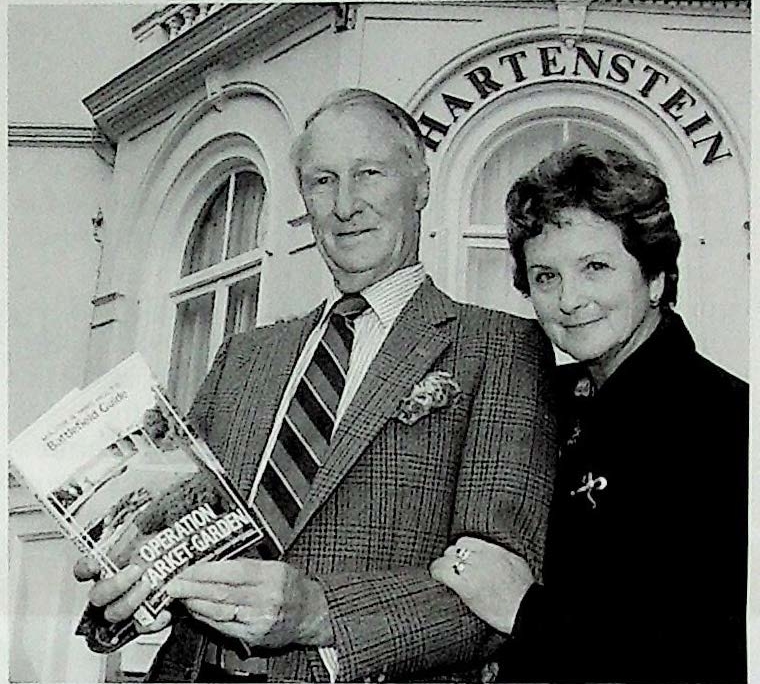
(Photo: Berry de Reus)
The ‘Operation Market Garden’ Battlefield Guide first gives an historic overview followed by an explanation of how the visitor, principally from England, can get to Leopoldsburg in Belgium, where the tour begins. Then, in five consecutive chapters, tours are described in the Leopoldsburg to Eindhoven region, from Eindhoven to Nijmegen, the surroundings of Groesbeek, the area of Nijmegen and the Betuwe, and finally, the battlefields at Arnhem, Oosterbeek and Driel. The individual tour sections can be undertaken separately, but they do connect with one another. However, anyone wishing to take in the entire tour in one go would need to set aside several days.
Each chapter contains a route description showing the locations of monuments, cemeteries, museums and other important sites. The text is interspersed with the recollections of veterans. There is also much useful information for the tourist, such as addresses of hotels, good restaurants and places of special interest in the close vicinity. More than two hundred colour photos give the visitor a good idea of what to expect in the region. No less than 300 monuments are described, and an accompanying map pinpoints all important locations.
The battlefield guide took two years to complete, during which time the Holts received a lot of help from people who are well-informed on local events. The final result is a guide that will certainly find its way to a wide group of users.
The well-known Pitkins guide is suitable for a short visit where one only requires simple information, while Colonel Waddy’s battlefield guide is intended for the more military-orientated visitor. However, the Holt’s guide is written for the true ‘battlefield tourist’, an ever-growing band of visitors. On page 38 the Holts state how they interpret the term ‘battlefield tourist’.
Now that the number of veterans is rapidly diminishing, ‘battlefield tourism’ will have to make a major contribution to keeping the memory of the Battle of Arnhem alive. This book, written by people who know their subject, has therefore appeared at exactly the right moment.
The Holt’s Battlefield Guide is for sale at the Airborne Museum.
Major & Mrs Holt’s Battlefield Guide, Operation Market-Garden-Leopoldsburg-Eindhoven- Nijmegen-Arnhem-Oosterbeek; Leo Cooper, Pen & Sword Books Ltd., 2001; ISBN 0 85052 785-6; 288 pages; illustrated; in English; price 55 guilders inc. map; loose maps 15 guilders.
(Wybo Boersma)
Urgent request
In one of the previous Newsletters we referred to the rules applying to the sale of articles during SFAM theme days and excursions. It would appear that some lack of clarity still exists, therefore this summary of the regulations.
Anyone wishing to sell books or other items, or to advertise the same, at a theme afternoon, AGM or excursion, is kindly requested to seek permission to do this well in advance of the function concerned. Requests by letter or e-mail can be made to Eugene Wijnhoud, Bernhardlaan 41-1,6824 LE Arnhem: tel. 026 3513100, e-mail e.wijnhoud@12move.nl.
(Eugene Wijnhoud)
‘De Zwarte Omroep’ and the Airborne
Even during the Battle of Arnhem, copies of the illegal Oosterbeek news-sheet ‘De Zwarte Omroep’ (chief editor and publisher H.W. Alferink, teacher) were being printed and distributed. It is not clear how many editions were produced, but according to the editor they were still being printed up until 19 September 1944.
He also reports (in the last paper to appear on 9 June 1945) that ’the editions of the last two days did not reach the readers because delivery had become impossible and due to the fact that our Airborne troops were crazy about the ‘underground press’ and begged for, and were given, the lot!’
The whole issue probably amounted to ‘just’ 20 copies, but, from the above, one can well imagine that numbers of ‘De Zwarte Omroep’ could possibly still be about within the circle of (families of) veterans. And perhaps there are still former British or Polish soldiers who have something to say on this. Or maybe they have already done so and their story is lying somewhere, patiently waiting for us!
If anyone should have any tips on this topic he/she is kindly asked to get in touch with Geert Maassen, Gemeentearchief Renkum, Postbus 9100,6860 HA Oosterbeek: tel. 026 3348303, e-mail gmaassen@renkum.nl.
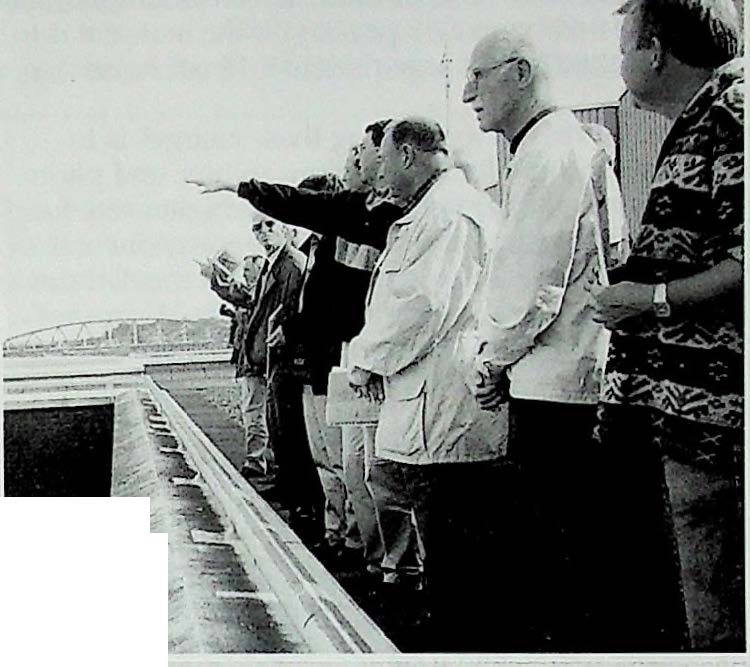 Nijmegen Excursion, 6 October 2001. From the roof of the NLION building Marcel Anker points out the spot where the 3rd Battalion of the American 504 Parachute Infantry Regiment crossed the Waal on 20 September 1944.
Nijmegen Excursion, 6 October 2001. From the roof of the NLION building Marcel Anker points out the spot where the 3rd Battalion of the American 504 Parachute Infantry Regiment crossed the Waal on 20 September 1944.
(Photo: Eugene Wijnhoud)
Market Garden 2 excursion
On Saturday 20 April 2002 the Documentation Group ’40-’45 will be repeating the excursion held by the Society of Friends on 6 October. The area to be visited is that around Nijmegen, where the 82nd American Airborne Division fought in September 1944. Members of the Society of Friends who were unable to make the first trip now have another opportunity. Once again our guide will be Jacques Haegens.
The excursion starts at 09.30 hours from ‘s-Hertogenbosch railway station. Cars can be parked at the Transferium. Lunch, which is included in the excursion price, will be taken at Groesbeek. We shall arrive back in ‘s-Hertogenbosch at about 17.00 hours. The cost of the trip is € 30 (/ 66.11). Places will be allotted in the order of booking and one will only be notified if all seats are taken.
For more information contact W. Boersma, tel 0318 639633, e-mail w.boprsma@wx« nl (Wybo Boersma)
News from the Airborne Forces Museum
The curator of the Airborne Forces Museum in Aidershot has informed us of the new regulations regarding the charges for using photographs from their collection and for consulting the archive. At present the costs for reproducing and printing a photo are £ 10.50, and this applies to photos exclusively for personal use. If the picture is intended for use in a publication the cost per print is £ 60. The copyrights of the photos remain the property of the Airborne Forces Museum.
The charge for a non-commercial consultation of the museum archive is £ 15 per day. If the material is to be published this charge rises to £ 15 per hour.
The major reason for levying these charges is to generate income for keeping the archive and photo collection up to scratch. Charging a higher rate for material that is to be published is because income from publications using material from the Airborne Forces Museum archive rarely benefits ‘Aidershot’. One can contact the museum staff for more information.
Before the opening of the Dorset Terrace at De Westerbouwing on 20 September, veteran Walter Smith was brought across the Rhine by boat, as he was in September ‘1944.
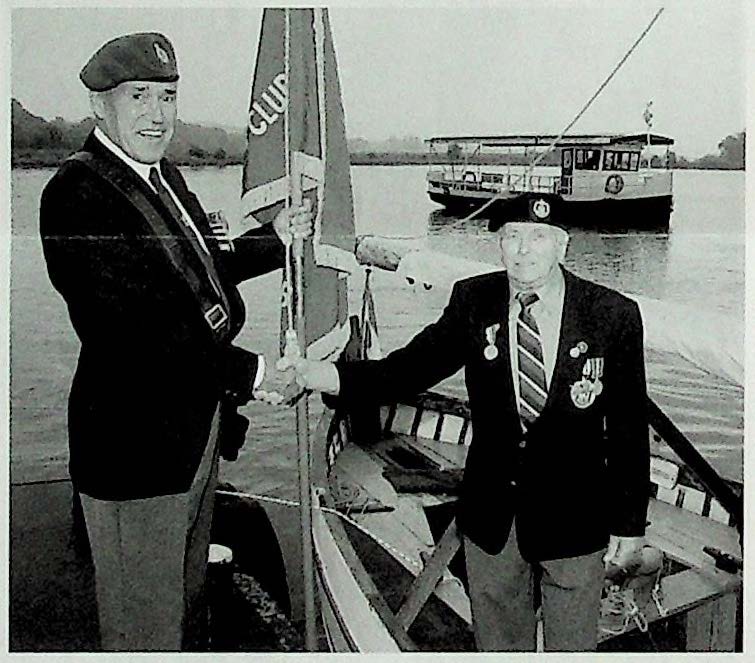 (Photo: Berry de Reus)
(Photo: Berry de Reus)
Dorset Terrace
On Thursday 20 September the official opening of the new Dorset Terrace took place at De Westerbouwing near Oosterbeek. The terrace is named after the 4,h Battalion The Dorsetshire Regiment, which crossed the Rhine at the Driel ferry crossing point during the night of 24/25’September under heavy German fire. The aim was to help the isolated Airborne troops in Oosterbeek. Part of the battalion tried to take the German-occupied Westerbouwing hills, and suffered heavy losses in the attempt.
The Dorset Terrace was opened in the presence of Dorset veteran Lance Corporal Walter Smith from Ramsgate.
Remains of a fallen serviceman found at Driel
On Monday 4 September the remains of a soldier were uncovered during excavation work to the south east of Driel. Over the next ten years this 450-hectare area of land, that lies between the Arnhem-Nijmegen railway embankment and the village of Driel, will become the new Arnhem district of ‘De Schuytgraaf where approximately 6,500 houses are scheduled to be built.
Between September 1944 and the end of the war this part of the Over-Betuwe was in the front line. The Polish Parachute Brigade landed here on 21 September 1944, and there followed days of heavy fighting. The area was also under continuous Allied and German fire during the winter of 1944-1945.
The terrain is being systematically searched because it is still thought to conceal much explosive material. It was during this search that the remains were discovered. According to Adjutant F. Bolle of the Recovery and Identification Service of the Royal Netherlands Army the remains are probably those of a British soldier. A rapid start has been made on an investigation that could possibly lead to an identification.
Exhibition at Deelen
Hoenderloseweg 10 in Deelen has for years been the home of the ‘Deelen Airfield Museum’. It was set up by a group of enthusiastic members of the ‘Dutch Aircraft Examination Group’ Foundation.
At the moment the museum has four different exhibitions. Firstly, the history of Deelen airfield between 1910 and 1995 is shown. Then there is a large exhibition, ‘Recover and Preserve’, in which the focus is on the history of the air war over the Netherlands, 1939-1945. Exhibits include flying clothing, navigation material, aircraft weaponry and many remains of recovered aircraft wrecks.
All material in the ‘Gliderborne’ exhibition has been provided by Paul Hendriks from Wolfheze. Over the years Paul has built up a huge collection of documentation about and material from Horsa, Hamilcar and Waco gliders. The majority originates from the former landing zones at Wolfheze. It is fascinating to see what has been found of these gliders.’
A large selection of the photographs used in the ‘Green On’ exhibition about the history of the British Air Despatches held in the Airborne Museum in 2000 is now on show in Deelen.
The Deelen Airfield Museum (tel. 026 3531434) is open on Saturdays and Sundays from 11.00 to 17.00 hours. Thoroughly recommended!

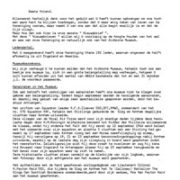
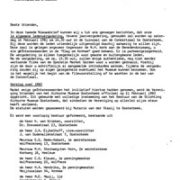
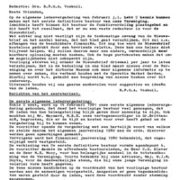
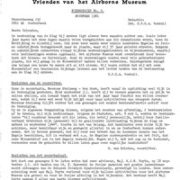
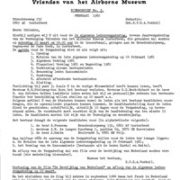
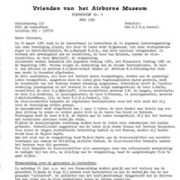
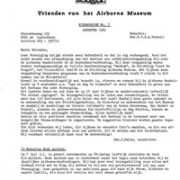
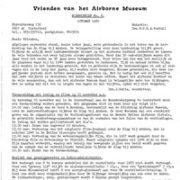
Plaats een Reactie
Vraag of reactie?Laat hier uw reactie achter.